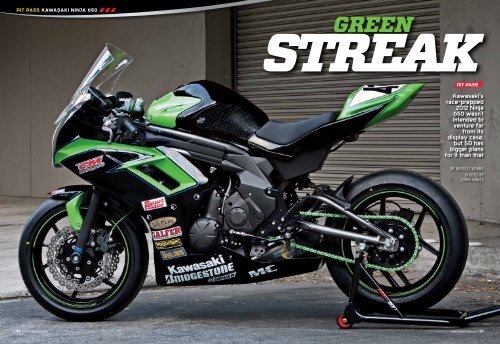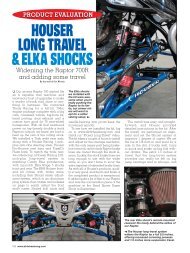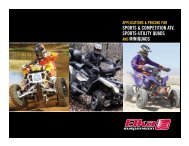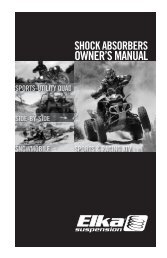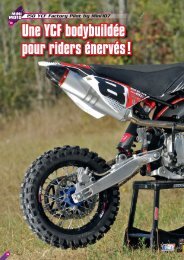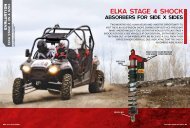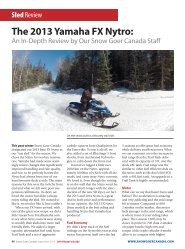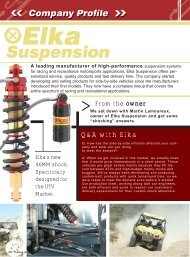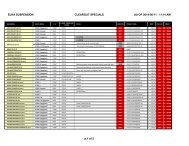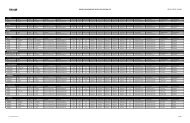Kawasaki's race-prepped 2012 Ninja 650 wasn't ... - Elka Suspension
Kawasaki's race-prepped 2012 Ninja 650 wasn't ... - Elka Suspension
Kawasaki's race-prepped 2012 Ninja 650 wasn't ... - Elka Suspension
- No tags were found...
You also want an ePaper? Increase the reach of your titles
YUMPU automatically turns print PDFs into web optimized ePapers that Google loves.
Pit Pass Kawasaki <strong>Ninja</strong> <strong>650</strong>GreenStreakPit PassKawasaki’s<strong>race</strong>-<strong>prepped</strong><strong>2012</strong> <strong>Ninja</strong><strong>650</strong> wasn’tintended toventure farfrom itsdisplay case,but SR hasbigger plansfor it than thatBy Bradley AdamsPhotos byJorge Nunez54 www.sportrider.com SPORT RIDER March 2013 55
Pit Pass Kawasaki <strong>Ninja</strong> <strong>650</strong>Those who follow Sport Rider on Facebook,Twitter or any other social networkwill recognize the <strong>Ninja</strong> <strong>650</strong> thatg<strong>race</strong>s these pages. The bike is one of Kawasaki’s<strong>race</strong>-<strong>prepped</strong> project bikes, a fully faired <strong>650</strong>twin that we blasted across the internet duringthe <strong>2012</strong> model’s press launch. We knew very littleabout the bike at the time of the event, only thatit looked overly capable in <strong>race</strong> trim and that ouriPhone camera could hardly capture its appeal.We also knew that, in time, we’d have to throw aleg over its saddle and test the <strong>Ninja</strong> <strong>650</strong>’s trackprowess. Twelve months later and our plans havejust about come to fruition, although we’ll admitthat the road to the <strong>race</strong>track wasn’t without itsshare of speed bumps.The snag in our arrangement was this: Kawasakinever had big intentions of putting its <strong>Ninja</strong><strong>650</strong> project bike on the track — at least not in itsthen-current state. “The bike was kind of puttogether as a display bike, and basically we justwanted to show that the <strong>650</strong> is track worthy,”says Kawasaki’s Brad Puetz, who goes on toreveal that “We were looking to develop the bikedown the line and do some testing so that wecould <strong>race</strong> it, but that plan kind of fell through.”The result was a bike that looked the part, butone that admittedly needed some attention if itwere to ever end up on the podium in any <strong>race</strong>.Sport Rider was quick to pick up whereKawasaki left off and eager to put the projectback on track. The excitement led initially to acompilation of parts that’d be needed to makethe bike competitive and then to a phone callwith Tige Danne of CycleMall Motorsports andCatalyst Reaction <strong>Suspension</strong> Tuning, a pair ofSouthern California-based companies who weknew had built a handful of <strong>race</strong>-winning Kawasaki<strong>650</strong>s in the past. Danne excitedly agreed tolend a helping hand where need be, and Bradleynot surprisingly volunteered to <strong>race</strong> the bikeupon it being buttoned up, thus Sport Rider’s<strong>Ninja</strong> <strong>650</strong> effort was born.Article deadlines in mind, we were excitedto find that Team Green and Carey Andrew ofHypercycle had already completed much of thetime-consuming track prep. Pinch bolts andfluid-retaining hardware had already been safetywired for example, and the engine coolant hadbeen replaced with a non-glycol-based coolantthat would conform to any <strong>race</strong> organization’sstandards and not slick the track in the eventof a crash or spill. Kawasaki’s crew took thingsa step further and rewired the <strong>650</strong> so that wecould forgo the key and unnecessary handlebarswitches. While this is an unnecessary — andlengthy — job, we were excited to see that Kawasakihad gone the extra mile to transform theproject bike into a true trackbike.The <strong>Ninja</strong> <strong>650</strong>’s street pedigree was further56 www.sportrider.comAnodized black Sato rearsets were a last minute addition and replaced a set of bulky prototypefootrests that’d been installed in a hurry just before the <strong>Ninja</strong> <strong>650</strong> project bike’soriginal debut. The new Sato Racing pieces were worth the wait and provide an extensivelevel of adjustment for any height of rider.A <strong>race</strong>bike typically requiresmore apt gearing and a higherstrengthchain, which is why weturned to Driven Racing, a longtimeparts supplier who offershigh-quality sprockets in a largeselection of sizes.Notice alsoKawi’s clever setup for the axlenut retainer.Stock forks house an OhlinsNIX 30mm cartridge kitthat’s been tuned by CatalystReaction <strong>Suspension</strong> toprovide better damping characteristics.Compared to thenon-adjustable stock unit,the new front end provides agreat deal of tuning for thetrack. Galfer stainless steelbrake lines are green — whatelse? — and should provide betterand more consistent brakeperformance during a <strong>race</strong>.An <strong>Elka</strong> shock courtesy of CatalystReaction is fine-tuned with settingsthat have been garnered from yearsof <strong>Ninja</strong> <strong>650</strong> <strong>race</strong>bike development.Compared to the shock that the <strong>Ninja</strong>project bike was shipped with, the<strong>Elka</strong> unit is longer and equipped witha more sufficient valve stack.A Yoyodyne slipper clutch was among ourexcessive additions, but should providebetter stability at the entrance ofthe corner and ultimately cutlap times. The clutch boltedin easy enough and doesn’trequire any added maintenancewhen compared tothe stock unit.Zero Gravity’s doublebubblewindscreen hasbeen mounted in thetallest of the <strong>Ninja</strong>’sthree mounting positionsto provide adequate windprotection for our six-footthree-inchrider.The LeoVince Underbody EVO II exhaust isstainless steel with a carbon end cap that’sclaimed to dissipate heat better and not affecttire temperature. The exhaust utilizes a largersub muffler as well, which should quell theexhaust note.Kawasaki made a noticeable effort to transformthe <strong>Ninja</strong> into a track weapon prior to handingthe bike over to us. Unnecessary switches wereremoved and the important ones relocated.Additionally, the ignition was removed and thetumblers in the fuel tank cap removed so thatthere’s no need to fumble with a key.SPORT RIDER March 2013 57
Pit Pass Kawasaki <strong>Ninja</strong> <strong>650</strong>CORRECTED HORSEPOWER/TORQUE75604530153 4 5 6 7 8 9 10 11RPM (x1000)Our <strong>race</strong>-<strong>prepped</strong> <strong>Ninja</strong> is just over four horsepower stronger than the last <strong>Ninja</strong> <strong>650</strong> we testedthanks in part to the LeoVince exhaust and some fine-tuning on the dyno.discombobulated with the addition of CatalystRacing Composites bodywork ($812 whenshipped with Dzus fasteners), which was broughtto life by MC Pro Design, an accomplished paintcompany who’s put the finishing touches on anumber of AMA Pro Racing bikes, including theGraves Yamaha R6s and R1s. The paint cost justa tick less than the bodywork itself and putKawasaki back $<strong>650</strong> — a small expense whenyou consider how sweet the project bike lookswhen so equipped. A quick call to MC Pro Designconfirmed that there are cheaper options;“Prices range from $350.00 and up dependingon what you would like on your bike.” Also worthmentioning, the company can make decals and58 www.sportrider.comHORSEPOWERStock: 62.2 @ 8800 rpmModified: 66.9 @ 8800 rpmTORQUE (FT-LB)Stock: 41.8 @ 6900 rpmModified: 43.5 @ 6900 rpmBridgestone BattlaxRace Tires for Dry Slickinstall them before applying clear coat, an optionthat wasn’t employed this time around.Clip-on-style handlebars wouldn’t work withthe <strong>Ninja</strong>’s stock body panels but were an obviousnecessity with the <strong>race</strong> bodywork mounted,which is why the next phone call was to the crewat Woodcraft Technologies, who offers threepiececlip-ons ($154.99) that are touted as beingeasier to install and remove. The real benefitof going with Woodcraft, at least from a <strong>race</strong>r’spoint of view, is that the company offers a largeassortment of replacement parts that are bothcheap and readily available, something that’simportant to consider when putting together anapt spare-parts kit for the track.Although many <strong>race</strong> organizations and <strong>race</strong> classes mandate DOT-approvedrubber, CVMA’s Formula classes have no such regulations, thus our decision torun Bridgestone’s JSB1000 dry slick <strong>race</strong> tires on our <strong>Ninja</strong> <strong>650</strong> project bike.The tires are available in multiple sizes and in three compounds, an ultra soft(YDC), soft (YCX) and medium (YCY), each of which we considered using based onChuckwalla’s track surface and expected track temperatures. In the end, we wentwith a YCX front and YCY rear, a combination that we feel will offer great longevityin addition to sufficient grip. We don’t expect our 67-horsepower <strong>race</strong> bike tohave an overwhelming tendency to test grip limits of course, but we’re absolutelylooking to garner as much traction as possible come <strong>race</strong> time.The slick tires should offer multiple advantages when compared to a set ofDOT <strong>race</strong> tires, including a more stable and consistent feel thanks to no treads.We’re excited also to see how many tires it takes to get us through three fulldays at the track; one of the ideas behind small bike racing is that it’s easier onyour wallet, and if we can make our two sets of tires last for an ample amount of<strong>race</strong>s, we should theoretically be able to keep our expenses within check.For price and availability regarding Bridgestone’s dry slick tires or any of itsDOT <strong>race</strong> tires, be sure to refer to your local <strong>race</strong> tire distributor.There are more additions up front, includinga set of highly adjustable CRG roll-a-click foldinglevers ($129.95 each); an Öhlins steering damperthat should quell front-end movement at thetrack; a more aerodynamic Zero Gravity doublebubblewindscreen ($94.95) that’s mounted in thetallest of the <strong>Ninja</strong>’s three positions for too-tallBradley; and Galfer Superlight series brake linesthat are a stainless steel construction for betterand more consistent braking performanceover the course of a <strong>race</strong>. A couple of things tonote: CRG doesn’t currently offer levers for the<strong>Ninja</strong>, but Kawasaki had apparently swapped the<strong>650</strong>’s clutch perch and master cylinder for aset of ZX-6R pieces, which ultimately opened thedoor for such accessories. A similar modificationwould appear to be extremely beneficial for all<strong>Ninja</strong> <strong>650</strong> owners.The <strong>650</strong>’s footrest mounting system and rubber-mountedfootpegs proved a disappointmentin last year’s full test (“Affordable Fun,” June ‘12)and warranted a call to Sato Racing, who hadreleased a set of adjustable, CNC-machined rearsets($<strong>650</strong>) for the Kawasaki just weeks beforethe project bike was to be completed. The rearsetsproved worth the wait and allowed for nearperfect positioning thanks to multiple footpegand shift linkage mounting positions. The Satounits are also nice in that they use well-knurledfootpegs for a sufficient boot/peg connectionand utilize ball bearings for the shift and brakelevers as well, ultimately alleviating any sloppinessin shifts.The <strong>Ninja</strong>’s inline-twin engine doesn’t exactlymatch the bike’s aggressive outward appearanceand is without any <strong>race</strong>-spec cams,high-compression pistons or head work. TheBradley AdamsImportant to mention is thatan identical shock to whatwe’ve used will be availablein the near future; considerus willing guinea pigs.lack of costly internal modifications meanspower is nearly on par with the last <strong>650</strong> weput on the dyno, although to the project bike’scredit, there’s a slight increase in power thatcomes courtesy of a LeoVince Underbody EVOII exhaust ($809). The system is one of twoLeoVince options and has more advantagesthan just increased power, claims the exhaustmanufacturer. “We found that the stockexhaust would heat the right side of the tire,but the carbon fiber tip on the [Underbody EVOII] exhaust dissipates heat better and keeps thetire temperature down,” says LV’s Tim Calhoun.LeoVince also notes that its Underbody exhaustis quieter than most <strong>race</strong> exhausts thanks inpart to a sub muffler, something our paddockfriends will likely appreciate during early morningengine warm-up sessions.Power may not have been the primary concernwhen it came to the <strong>Ninja</strong>, but that’s not to saywe didn’t want to show up to the <strong>race</strong>track with astrong performing bike. Point in mind, we turnedto Driven Racing and Dynojet, both of whomhave an extensive history at the track. From theformer we garnered a set of sprockets ($65.97for the rear, $31.46 for the fronts) and a greenchain ($170.22), while from the latter Kawasakipurchased a Power Commander V ($399.95) anda quickshifter ($276.47), two components thatwould make tuning and riding the <strong>Ninja</strong> in angermuch easier. We also put in a call to Yoyodynebased on a suggestion made by Danne, whoclaimed that a slipper clutch would pay big dividendsin terms of corner-entry stability and laptimes. An $850 credit card charge later and wewere so equipped.Danne and Catalyst Reaction’s JamesMorse put the project bike’s chassis under theknife — in spite of the fact that Kawasaki hadalready installed an aftermarket shock and aZX-10R-culled Öhlins NIX 30mm front fork cartridgekit. “The bike was sitting way too high inthe front and really low in the rear, so we reallyneeded to work on the chassis and get thesuspension dialed in,” says Danne. The changesthat ensued include new springs, updated valvestacks that’ll ideally provide better dampingcharacteristics through the stroke and a newride height measurement. Out back, Tige mademore drastic changes in the form of an all-new,prototype-style <strong>Elka</strong> shock that offers more rideheight and is equipped with a valve stack that’sResourcesBridgestone Tireswww.bridgestone.comCatalyst Racing Composites(760) 510-9799www.catalystracingcomposites.comCatalyst Reaction <strong>Suspension</strong>Tuning(714) 258-7501www.catalystsuspension.comCRG(831) 763-7811www.constructorsrg.comCyclemall(714) 258-7501www.cyclemall.netDriven Racing(818) 775-0041www.drivenracing.comDynojet Power Commander(800) 992-4993www.powercommander.comGalfer USA(805) 988-2900www.galferusa.comLeoVince(510) 232-4040www.leovinceusa.comMC Pro Design(760) 738-0521www.mcprodesign.comÖhlins(800) 336-9029www.ohlinsusa.comSato Racing(831) 899-1822www.satoracing.comWoodcraft Technologies(978) 297-2977www.woodcraft-cfm.comYoyodyne(973) 386-0040www.yoyodyneti.comZero Gravity(800) 345-9791www.zerogravity-racing.comidentical to what he’s run on prior <strong>Ninja</strong> <strong>650</strong> <strong>race</strong>bikes. Important to mention is that an identicalshock to what we’ve used will be available in thenear future; consider us willing guinea pigs.The Cyclemall crew didn’t end their effortsthere, and willingly dyno-tuned the <strong>Ninja</strong> in a lastditcheffort to extract as much power as possible.The bike got a general going-through as well,something we recommend for every bike that’sheaded to the track.So what’s next for our <strong>Ninja</strong> <strong>650</strong>? We’re currentlyregistered to <strong>race</strong> at Chuckwalla ValleyRaceway with CVMA, a newly founded SouthernCalifornia-based <strong>race</strong> organization that’s shownto offer especially great competition in the lightweighttwins classes. Check back next month tosee how our little <strong>Ninja</strong> fares. srSPORT RIDER March 2013 59


